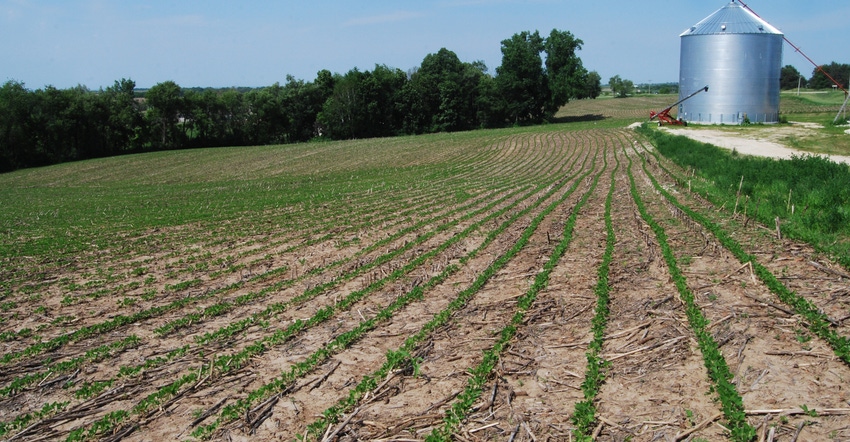May 19, 2017

It’s been a challenging spring, and we wouldn’t expect the postemerge spraying season to be any different. With all the early-season moisture and erratic temperatures, both burndown and residual herbicides have been pushed pretty hard. Postemerge soybean applications have their work cut out for them. While most corn and some beans have been sprayed already, there are quite a few acres to go. Timing and tactics for the postemerge soybean spray trips is a topic growers and agronomists often discuss.
What is the right timing for postemerge bean spraying?
I’ll throw this out there right away to cover us on any application question: The label is the law. In general, the right timing for postemerge spraying is “early,” which we’ve struggled with for decades. Whether it’s Mother Nature keeping us out of fields or trying to wait until “most of the weeds are up,” early post applications aren’t always made in what we’d consider the “early” window.
“Early” is sort of an abstract concept; a solid way to define it is to scout your beans and let your field tell you. Knowing what your most pressing weed issues are in terms of size and density, and then cross-checking that with your herbicide choices will define “early” in a hurry. For a lot of our postemerge soybean herbicides, 4 inches is a common maximum weed size for many problem weeds we face. Even after all the scouting and spraying I’ve done from my retail years to today, I’m still astounded at how fast a field can go from being pretty clean to having weeds pushing that 4-inch label limit.
Experience has taught me that scouting is the key to guiding the timing of early post spray trips. You may laugh, but try this: Take a tape measure out and measure your weeds. Maybe it’s just me, but when scouting the first few early-emerging fields — before I’m “calibrated” for the year — the weeds almost always seem well under label size. After putting the tape to some of these weeds, I find that sometimes they are closer to needing spraying than I thought.
How can we maximize effectiveness of post-applications?
Besides being the “law,” a fair number of herbicide labels give some pretty solid insight for making their product work better. For example, a lot of products have a minimum spray volume per acre requirement, with 10 gallons per acre (GPA) being relatively common. If you read on, the label may allow you some latitude to gain a tactical advantage. You may find guidance like, “Use a higher spray volume when treating dense vegetation” or “Higher spray volumes may also allow the use of larger nozzle orifices (sizes) that produce coarser spray droplets” to optimize coverage.
You’ll also find interesting information on additives and use of non-ionic surfactants (NIS), crop oil concentrates (COC), methylated seed oils (MSO) or high surfactant oil concentrates (HSOC). For example, a product I work with a lot recommends COC as the preferred adjuvant under good conditions, but goes on to say that “a higher rate is required when weeds are under environmental stress, such as low temperature, low humidity or low soil moisture.” So along that line of thinking, I often recommend using the high end of recommended rates of adjuvants. I also tend to recommend using labeled adjuvants on the more “aggressive” end of the spectrum.
While strategies like these are designed to increase efficacy on weeds, there can be trade-offs. Phrases like “Some COC, HSOC and MSO adjuvants may cause a temporary crop response” illustrate there is some risk involved when we heat the application up trying to battle tough weather or hard-to-control weeds. Your current scouting report and past experiences, along with advice from your local ag retailer, can help in getting the right mixture put together for each field; there isn’t a one-size-fits-all approach.
Double-check and make note of any other information that could make or break an application. During my retail days I learned this the hard way. With a fleet of sprayers going seven days a week from dawn to dusk (within labeled weather conditions), I just plain lost track of an important bit of trivia relating to a new product. If you sprayed within a couple of hours of sunset, control of certain weeds could drop precipitously. Some of the fields had to be sprayed again, thanks to my oversight. A good takeaway from this is there are a significant number of products that have something “out of the ordinary” like this in their label that can make a huge difference in performance. Read carefully.
Can we increase sprayer speed to get more done in the “early” window?
With the advances in suspensions and guidance systems, in some cases we are operating sprayers pretty close to label limitations already. But if there is still room for more mph within label restrictions, be sure to consider the travel speed to find the appropriate nozzle and size to get the coverage we need while minimizing drift potential.
I like this example from our ISU Extension ag engineer Mark Hanna: If field speed increases by 25% (e.g., going from 12 to 15 mph), spray pressure for a given nozzle must increase by 56% (e.g., from 40 pounds per square inch to 63 psi) to maintain output. A better choice to reduce smaller droplets and minimize drift would be to increase nozzle size.
Another factor that dovetails with speed is boom height. With drift potential increasing as boom height rises, some herbicide labels (the new soybean dicamba products, for example) put a limit on boom height in addition to speed. For those without automatic boom management systems, it’s a real challenge to maintain a maximum of 24 inches above the spray target (dicamba, for example) at normal speeds. Even with automatic boom controls, as speed increases, it’s harder for the system to respond accordingly. Be ready to intervene if needed.
What is the “wheel track” yield penalty for spraying later?
Research suggests an adequate soybean stand (more than 100,000 plants per acre) planted in late April through mid-May can compensate for wheel tracks made when a field is sprayed at R1 growth stage. Yield loss can occur, however, when wheel tracks are made at R1 or later in thin soybean stands (less than 100,000 plants per acre) or in late-planted beans. After the long and wet spring, we have areas in the state with thin stands and later-planted beans unfortunately. These would be a good candidate for spraying in earlier stages to limit damage.
Regardless of stand, plants could not compensate for wheel tracks made at R3 (early pod development) or R5 (early seed development). The average yield loss per acre is based on sprayer boom width (distance between wheel track passes). In our trials, yield losses averaged 2.5%, 1.9% and 1.3% when sprayer boom widths measured 60, 90 and 120 feet, respectively. Multiple trips along the same wheel tracks did not increase yield loss over the first trip.
I’d be remiss if I didn’t wrap up by sharing some not-so-subtle reminders about where we are with challenges like herbicide resistance and Palmer amaranth. When you have a break in the action, take a look at the ISU 2017 Herbicide Guide. It has a lot of useful information to help fine-tune product selection and ensure your weed management program incorporates multiple, effective herbicide groups at effective rates as part of a long-term weed management system.
McGrath is the On-Farm Research and Extension coordinator for the Iowa Soybean Research Center at Iowa State University.
About the Author(s)
You May Also Like






